Learn Affiliate Marketing For Beginners: Ultimate Guide

Ultimate learn affiliate marketing for beginners guide. Are you looking to learn how to earn with affiliate marketing?
Affiliate marketing is the #1 way I earn money with my blog, bringing in over $500,000/year. Today I wanted to share my affiliate marketing success tips, to help you succeed in affiliate marketing.
As an affiliate partner of various brands and sponsored content, HerPaperRoute may earn commission on qualifying purchases. Disclaimer
Consider this post your very own learn affiliate marketing for beginners crash course.
I’m going to explain the ins and outs of the trade, so you can start making money with your blog now.

Learn Affiliate Marketing For Beginners: Ultimate Guide
Picture this. .. It’s Saturday night and you’re out having drinks with some friends. “Ding!” Your phone goes off.
It’s Gmail, letting you know that you just earned $100 from an affiliate sale.
Sweet. Bartender — another round, please!
When you learn affiliate marketing and do it right, you can receive email notifications like this one every single day and make money while you’re out living your life.
Sounds pretty good, right?
In today’s post, I’m breaking down everything you need to know about creating a successful affiliate marketing strategy for your business. By the end of this post, you’ll have a detailed, actionable strategy for making consistent sales as an affiliate.
You may have been inspired to start one or more of your own affiliate marketing websites after seeing the blog income reports of bloggers who earn $10,000, $50,000 even $100,00+ per month.
If you are a new blogger and you want to make money from your blog, affiliate marketing is the best income source to start with.
When I first started blogging, I could not believe there were bloggers making thousands of dollars each month without creating a single product of their own.
Honestly, it wasn’t until I received my first affiliate commission of $65 that I truly began to see how affiliate marketing could be a substantial portion of my online income.
Let’s explore how to monetize your blog with affiliate marketing, step by step.
But first, make sure you get your FREE access to my resource library of tools, ebooks and exclusive training on affiliate marketing, social media, blog monetization and more.
Learn Affiliate Marketing Strategy eBook: Today you can score a copy of my affiliate marketing book!
What Is Affiliate Marketing?
A simple definition for affiliate marketing is the practice of promoting products or services created by other individuals or companies and receiving a commission on any sales that you make.
An affiliate is someone who promotes another company’s products or services to their own audience. When a purchase is made through their affiliate link, that person receives a commission from that sale.
Commissions will vary from program to program, but they’ll either be a set dollar amount (e.g., $25/sale) or a certain percentage of the sale (e.g., 25% of every sale).
The beauty of affiliate marketing is that you don’t need to create your own products to sell, which can be really time-intensive. You can simply promote other people’s stuff and skip past the long, tedious phase of developing a product or course of your own.
In my opinion, affiliate marketing is one of the best income sources for bloggers in any niche.
Affiliate Marketing Definition:
Affiliate marketing is the job one does to promote a brand’s products or services, whereby you earn a commission for referring sales.
Affiliate marketing is when you earn money by promoting other people’s products/services.
Typically, you will build your own affiliate marketing websites using WordPress and do most of your promotions by writing blog content about your affiliate products.
You earn money whenever someone makes a purchase after clicking your affiliate link.
How Does Affiliate Marketing Work?
First, here’s a general overview of how the affiliate marketing process looks.
In a nutshell, to learn affiliate marketing as a beginner, this is how affiliate marketing works:
- You build an affiliate marketing website (I’ll show you how in a moment)
- You find a product you like
- You join the affiliate program of the brand (aka the company) who sells the product
- Once you’re accepted to the program, the brand gives you a unique tracking code called an affiliate link. Any clicks on this link will be cookied and tracked for a certain period of time.
- You then take the affiliate link and embed it within blog posts, emails, social media posts, etc. You promote the product or service from that company and share your affiliate link.
- You create content (blog posts, ebooks, social media posts ect) in promotion of the product, using your affiliate link.
- When someone makes a purchase after clicking your affiliate link, you earn a portion of the sale, called a commission. The customer doesn’t pay any extra. Your commission is paid to you by the brand.
- Usually, you’re notified when a sale is made through your affiliate link
- You receive a commission from each sale you referred. Generally, there is a 30-60 day payout delay for affiliate commissions.
When I have a good experience with a product or service that I use on my blog, I always look into joining the affiliate program of that product and sharing it with my readers.
It’s typically a very natural flow for me to promote an affiliate product. I can speak about the benefits from a first-hand perspective, explaining how I use the product and why I like it.
Sharing my personal experience helps to build credibility for the product, and makes the sale more likely.
What can I become an affiliate for?
You can become an affiliate for just about anything, including:
- Physical products
- Digital products like courses and ebooks
- Services and packages
The items you promote as an affiliate will vary depending on your niche and audience.
I encourage you to get creative with this, and to try promoting things in all three categories above to see which works best for you.
What Is An Affiliate Marketer?
An affiliate marketer is a person who connects a customer to a brand. Also referred to as the ‘publisher’ or simply the ‘affiliate.’
The affiliate marketer is the ‘webmaster’ of their own affiliate marketing websites, and they publish content in promotion of the brands that they are affiliated with.
An affiliate marketer is often a blogger who creates blog content about products and shares their opinions of the products.
An affiliate marketer earns a commission when someone buys the product which they recommend, after clicking through their affiliate link.
What Is The Goal Of Affiliate Marketing? What Is The Purpose?
I don’t need to beat around the bush here, and I have no problem with telling you like it is.
The goal of affiliate marketing is to make money.
For the marketer, their goal is to earn commissions from their promotion efforts, recommending a brand’s products.
And for the brand, their goal is to make more sales, by way of their affiliate team’s promotion efforts.
Related: How to start an affiliate program for your business
Affiliate marketing is a mutually beneficial partnership between both sides.
- Money for the brand by achieving more sales of their products. Affiliates help increase sales for a brand, by having their products seen by a wider audience.
- And money for you, the blogger by way of commissions on the referrals you send to the brand.
However, it goes deeper than that.
Because being successful at affiliate marketing takes a lot more than just being a good saleswoman.
To learn affiliate marketing and be successful at it you actually need to be a great content creator, one that provides honest and helpful resources to your readers.
Building relationships with your readers and gaining their trust by being honest and real is how you make it as an affiliate marketer.
No one wants to make purchases from someone who is seen as slimy, pushy or salesy.
To have success with affiliate marketing you really do need to be a helpful and honest resource to your audience first and foremost.
That being said…
A Big Reason Why I Support Bloggers / Affiliate Marketers Is…
Whenever I need to buy something online, I always go to my favorite bloggers’ websites and purchase the thing I needed via their link.
Sure, I could go directly to the brand’s website or Amazon to make the purchase, but I’d rather support a blogger.
It takes two seconds to click through a blogger’s affiliate link and land on the brand’s website before making my purchase – and those two seconds are well worth it.
It doesn’t cost me any extra money, and often it is actually cheaper to buy something via a blogger’s link as they will often have a partner discount.
But the big reason why I do it is that it feels great to support a fellow blogger who you know appreciates the sale.
Knowing that she is probably at home doing a little happy dance seeing a commission come in is why.
Honestly, a little happy dance is what I do whenever I earn a commission!
I don’t think any ‘big brand’ does any happy dance or really cares when you buy directly from them, after all!
7 Reasons To Learn Affiliate Marketing Today
There are many reasons to learn affiliate marketing.
And, RIGHT NOW is the best time to get started!
The sooner you get started, the sooner you’ll go through the learning curve and get into the money-making stage.
Because I’m not going to lie to you and say it’s easy….. it isn’t.
Many affiliate marketers fail in the first year, but many go on to make six-figure incomes.
What is the difference between the ones who win and the ones who fail?
I’ve thought about this a lot.
And my view is: successful affiliate marketers just never gave up, even if they had failures.
Unsuccessful affiliate marketers give up after a few months when they didn’t see the pot of gold immediately and they don’t have the drive to keep going.
So, if you’re a determined person, willing to keep working and learning, affiliate marketing is for you.
If that sounds like you, here are the 7 reasons why you should start affiliate marketing.
1. Affiliate Marketing Is Cheap or Free to Set Up
Once you learn affiliate marketing, you can start promoting products from big affiliate programs for free.
Some of the big affiliate networks are; ClickBank, Amazon Associates, JVZoo, ShareASale and CJ Affiliate to name a few and are all free to sign up as an affiliate.
Alongside finding an affiliate product to promote, you will need places to promote your products.
This can be done via a website that is super easy to set up and costs only a few dollars a month in the first year. Check out my step-by-step guide on how to set up a money-making blog.
If you don’t want to set up a blog, you can start affiliate marketing with no money, for free on your social media accounts.
And you can leverage social media to help promote your offers which is free also!
You can choose one social media platform at the start and then branch out.
The most recommended sites to use as an affiliate are; YouTube (1 billion hours of video watched daily), Facebook (1.62 billion users daily) and Instagram.
2. Fast to Set Up
One of the biggest reasons to learn affiliate marketing is that it’s an extremely fast business model to set up.
After you’ve chosen an affiliate product to promote and your chosen social media channels to promote on, you can literally be up and running in a few hours.
Unfortunately, it might take a little longer for the profits to roll in, but if you take consistent daily action, it’s entirely possible to see some profit in a few months.
Of course, we all have varying work ethics and time to focus on affiliate marketing, but some affiliate marketers have been able to make a full-time income from affiliate marketing.
3. It’s a Simple Business Model
Affiliate marketing is literally recommending a product you love and know will help people and when someone buys through your link, you get a commission. Simple right!?
You don’t need to have in-depth knowledge of currencies, languages or something in particular – you can even promote kitchen or garden equipment if that’s your thing!
A 16-year-old school student or a 70-year-old retiree can start an affiliate marketing business.
There are no barriers to entry except if you don’t believe in yourself and are not willing to take action.
4. Low Risk
Gone are the days of having to invest thousands in renting a store, paying monthly bills and buying lots of stock that might not even sell.
There were always a lot of risks in starting up businesses that way.
But this is why starting an affiliate marketing business is a great option allowing you to promote other people’s proven products.
With affiliate marketing, you can start for free as mentioned, test out the products you choose with an audience and if they don’t sell, change your product or change your marketing plan.
The worst that can happen is that you won’t make money right away. It really is one of the lowest-risk business models out there.
5. Flexible Work Hours and Work From Anywhere
A big reason to learn affiliate marketing is, of course, to take back your time and not be a slave to the 9-5.
Work from the beach, from a cafe, from home or take your laptop on the road and be location independent.
You can run your affiliate marketing business from your laptop and you can work in the morning, afternoon or evening – it’s totally up to you!
Affiliate marketing also lets you be flexible with the type of work you do to promote your business.
Some marketers will focus on producing videos, some will focus on Facebook and some will lean more towards writing and building a blog.
There really is no right or wrong, it’s possible to build a super-profitable affiliate marketing business using all these methods.
6. Big Profits Are Possible
Many affiliate programs will pay 50-100% commissions and sometimes recurring commissions.
If the value of the product is high ticket $1000+, you can see how lucrative it can be.
Martin Lewis (the Money Saving Expert) created his website helping others save money for $100 around 10 years ago and the last I checked he was making around 1.5 million a month in affiliate commissions!
Absolutely crazy right!
This is an extreme example, of course, not everyone will create profits to that mega-scale, but many earn $100-$1000 a day which is pretty nice.
7. It’s Extremely Scalable
When you are considering why you should start an affiliate marketing business or any other business, you should consider the possibility of scalability.
If you don’t scale, you’ll never know what you can truly achieve with your business.
Affiliate marketing is a scalable business and as soon as you start making some profit, you can push a portion of that back into the business.
Such as by running Facebook ads, getting a mentor or taking an affiliate marketing course, creating your own course or adding new, high ticket offers to your funnel.
Affiliate marketing truly is one of the most scalable online businesses out there, with no ceiling on how high you can take your profits.
So, are you ready to stop asking why you should learn affiliate marketing and start building your own affiliate marketing empire?
How to Learn Affiliate Marketing as a Beginner
Now you know the reasons to learn affiliate marketing, you need to read the guide below.
It’s a good idea to get yourself some basic knowledge by reading as much as you can about affiliate marketing. And this will give you the best chance of success by reading and learning how it works.
Affiliate Marketing Examples
Here is an example of affiliate marketing in action:
When you click this link, or click the image above, it will take you to an online store where you can buy the theme bundle advertised.
That is my affiliate link. If you were to decide to buy something while there on that website, I would earn a commission, for referring your business to them.
How To Create Your Own Affiliate Marketing Website
The first thing you need, to learn affiliate marketing is you need a website. Your website will serve as the base where your affiliate promotions can live.
Here is a step by step guide to setting up a website for free, in just 10 minutes. We will discuss that more in detail in a moment.
Once you have set up your website and set up automation funnels to auto-promote it, it then becomes a source of revenue.
A source of revenue where sales happen at any time day or night.
When you run profitable affiliate marketing websites, you are literally making money while you sleep.
How Do You Create Profitable Affiliate Marketing Websites?
The first step in this Learn Affiliate Marketing For Beginners guide is to understand what affiliate marketing websites are.
Affiliate marketing websites (or blogs) are websites used for the purpose of making money via affiliate commissions.
If you aren’t familiar with what is affiliate marketing, then let’s back this up a minute and run through the basics of affiliate marketing right now.
How Much Does Affiliate Marketing Cost?
Affiliate marketing costs nothing. There are no direct costs associated with affiliate marketing.
You don’t have to buy anything in order to promote a brand/product and earn money as an affiliate.
There is no fee to participate in an affiliate program.
But of course, the only costs that you would pay are related to your website costs such as your yearly hosting and domain fee.
You can get web hosting for just $2.95 and a free domain here.
How Much Can You Make From Affiliate Marketing?
There is no limit to how much money you can make from affiliate marketing.
Some affiliates make a few hundred dollars a month, some make a few thousand dollars per month, others even make over $100,000 per month.
How much you can make with affiliate marketing only depends on how well you promote the right products to the right customers.
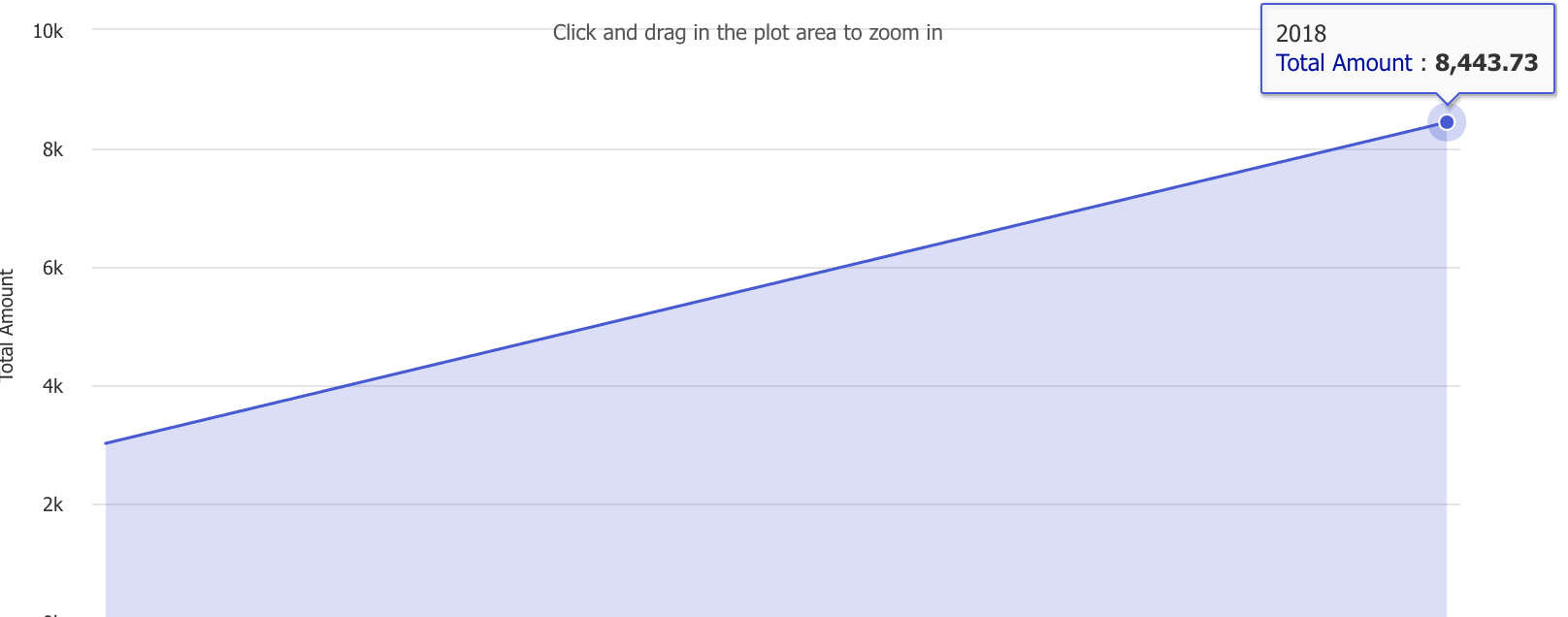
Here is a screenshot of my affiliate commissions from just one advertiser on the AWIN network.
If you aren’t yet part of AWIN, you really need to get on that!
*note their $5 sign up fee is credited back to your account as soon as you are accepted to the network.
You may have Googled “How much money can you make with affiliate marketing?” about a million times when you were first getting started.
Just knowing the potential earnings from this income source may motivate you to learn more about affiliate marketing.
The honest answer is that there really is not a ceiling on the number of affiliate commissions that you can earn each month.
Personally, I earned over $140,000 last year in affiliate sales, with a small, low-traffic blog.
I have blogger friends who have bigger, higher-traffic blogs, who are making over $100,000 per month with affiliate marketing.
How much money you make from affiliate marketing is really dependent on how well you can drive traffic to your affiliate offers.
More Traffic = More Exposure = More Affiliate Sales
Promoting high-quality affiliate products that are useful to your audience will help you to scale the amount of income that you earn from your affiliate links.
Before I walk you through the steps of how to get started with affiliate marketing, let me make one suggestion.
While it isn’t 100% necessary to have a blog in order to start earning money from affiliate marketing, I highly suggest that you do actually have one.
Many companies and affiliate networks will not approve you to become an affiliate partner without a blog or website.
In some cases, if you have a large social media following on Facebook or Instagram, you may be able to get by without having a blog.
But for most of us, having a blog is a prerequisite for affiliate marketing. If you don’t yet have a blog, start by enrolling in this FREE blogging class here.
If you are ready to get started with affiliate marketing, follow these steps.
As mentioned at the beginning of this Learn Affiliate Marketing For Beginners tutorial, the first thing you need in order to start making money with affiliate marketing is you need a website. And the only thing you need to buy is web hosting.
How To Create A Blog For Affiliate Marketing
- Click here to get your web hosting for just $2.95/per month, including a free domain.
- Once you have ordered your web hosting, follow this step-by-step beginners guide covering everything you need to do to set up your website correctly. (It is super easy, I promise!)
What Are Tiered Affiliate Programs?
Some affiliate programs work on a tiered basis. This means that the more affiliate sales you make within a given period of time (usually 1 month), the higher your commission per sale is.
For example, the tiers in a tiered affiliate program might look like this:
- For under 5 sales in a month, you earn $20/sale
- For 5-10 sales in a month, you earn $30/sale
- For over 10 sales in a month, you earn $40/sale
Most affiliate programs aren’t tiered. But I do think it’s a super smart way to run an affiliate program because it motivates the affiliates to promote and sell more.
Next, let’s get into the nitty-gritty.
How do you find and join affiliate programs?
This is the stage where a lot of people get hung up. How exactly are you supposed to find good affiliate programs to join?
This is my 3-step process for finding & joining the right affiliate programs for your business
Step 1. Make a list
Sit down with a pen and paper and put your thinking cap on. It’s time for a brain dump!
Think back over the past couple of years and ask yourself:
- What products, tools, programs, services, courses, and books have I purchased that I’d feel comfortable recommending to my audience? These items should be related to your niche Useful, interesting, or inspiring for the audience
- Things you yourself have used (or continue to use) and loved
Spend at least 10 minutes creating your list, writing down everything you can think of. At this stage, don’t worry about whether the products you write down have an affiliate program or not. That comes next.
Step 2. Locate the affiliate program for each item
Finding and joining affiliate programs isn’t as hard as you might think it is.
Here’s what to do:
- Go to the main website where each item is sold.
- Browse the website and look for words like “Affiliates” or “Partners” in the top menu, the sidebar, or the footer
- If you can’t find an affiliate application page, try using the website’s search bar.
Still no luck? Locate the company’s contact info and reach out to them to ask if they have an affiliate program and if so, how you can join it.
Step 3. Apply for each affiliate program
Most affiliate programs will have some sort of application for you to fill out, varying from quick-and-easy to super-dense-and-complex.
You’ll generally be asked for things like:
- Your domain name
- Your social media links
- Your monthly traffic stats Your
- Personal Identification Number (SSN or SIN) or Business Identification Number
- The plans you have for promoting the company’s products
Once you’ve submitted your application, you can sit back and wait to hear from the company. It shouldn’t take long for you to get approved.
Pro tip: The more affiliate programs you join, the harder it becomes to keep track of all your different affiliate links. This is why I personally use a spreadsheet to house all of my affiliate information, and I can’t recommend this strategy enough. Besides keeping your affiliate links organized, you can also your spreadsheet to record important information about each affiliate program you join. For example, things like your log-in info, the commission structure, and the cookie period length.
8 ways to make consistent affiliate sales
Joining affiliate programs is the semi-easy part.
Now comes the tough bit. How do you get people to click on your affiliate links and actually buy something?
If you find yourself struggling to make affiliate sales, here are eight different strategies you can use to share affiliate links with your audience:
- Include affiliate links within your blog posts
- Add affiliate images and links in your blog sidebar or website footer
- Share your affiliate links on social media
- Include affiliate links in the emails you send to your list
- Create a sales funnel that ends with an affiliate pitch
- Create a dedicated page on your website to feature your favorite affiliate products
- Include affiliate links in your opt-in freebies
- Include affiliate links in your courses and ebooks
- Always focus on how the item you’re promoting will benefit your readers. How will it improve their lives? What solution, result, or transformation is it providing? Paint that picture for them.
- Offer a bonus incentive for people who purchase through your affiliate link. For example, you could offer a mini-course, workbook, video tutorial, or coaching call. This is a great way to encourage people to purchase specifically through your link.
Affiliate Marketing Strategy And Best Practices
1. Find Affiliate Programs for Products and Services You Already Use
When you are getting started with affiliate marketing, I always suggest starting with a product that you already use and love.
For instance, if you are a fitness blogger, you have all kinds of products and services from exercise equipment to fitness apparel to diet plans and more that you have likely purchased for yourself.
Chances are that many of these products that you use have affiliate programs.
Visiting the website of the company you want to promote, and looking in their footer for any mention of their affiliate program is another way to find affiliate programs to join.
If you go to the websites of the companies that create these products, many will have an affiliate partner link that can be found somewhere at the top or bottom of their homepage.
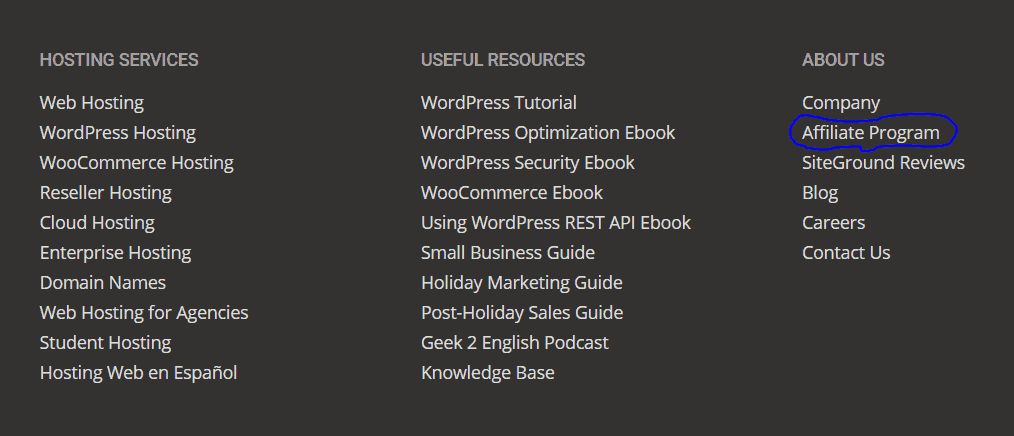
When you click on the link, it will generally take you to a page that gives you more information about the affiliate program.
Including the potential commission rates, a list of resources they get access to as an affiliate partner, and the process for signing up to be an affiliate partner.

While some affiliate programs will instantly approve you as an affiliate partner from the moment you complete the application process, other’s have a more rigorous process for accepting affiliate partners.
This process could include checking that you have a website, checking the level of traffic that your website received, checking your social media following, etc.
Unless the company specifically mentions certain thresholds that must be met before applying to their affiliate program, don’t let the what-ifs deter you from applying.
The worse that can happen is that you get rejected and you can just try to apply to the program again at a later time.
Did you know HerPaperRoute has an affiliate program? Join here!
What are the Best Affiliate Programs for Beginners?
As a beginner, it’s good to know what to look for in a good affiliate program.
First and foremost, I like affiliate programs that have a dedicated affiliate manager. A good affiliate manager will be able to answer any questions that you have and keep you updated on the affiliate program with weekly or bi-weekly emails.
Second, I love affiliate programs that have a recurring commission structure.
A recurring commission means that once someone clicks on your affiliate link and makes a purchase, you will continue to receive a commission payment each month as long as the person remains a paid customer.
A few affiliate products that I promote with recurring commissions include:
- Online Course Hosting.
- Commission: 30% monthly recurring
- Online Course Hosting.
- Commission: 20% monthly recurring
- Email Software.
- Commission: 30% monthly recurring
Get access to my little black book of recurring affiliate programs, for free!
How To Find And Join Affiliate Programs To Monetize Your Blog
Once you have decided on your format, start writing content.
Fill your website with at least 6 pages of blog content before you start applying to affiliate programs.
How to find affiliate programs to join is as simple as visiting my High-Paying Affiliate Programs Directory and joining affiliate networks such as AWIN.
Once you have joined a few affiliate programs, start researching the products. Then create some epic content on your in promotion of it.
Another good tip is to become an affiliate partner for high-paying affiliate programs. Personally, I consider an affiliate program high-paying if the commission is $50 or higher.
2. Find a Good Affiliate Network to Join
As you are reading other blogs, you may come across products that others are promoting and realize they are a good fit for your blog too!
On a blog I follow, I saw that this particular blogger was promoting a product from a website that I visit every week, but had no idea they even offered an affiliate program.
So, I investigated to figure out where this company’s affiliate program was being hosted.
As it turns out, the affiliate program was hosted on an affiliate network that I already had an account with.
I logged into my account with the affiliate network, found the affiliate program I was interested in, and then completed the 5-minute affiliate application.
I waited 24 hours or so for a response from the affiliate manager, then did a little dance for joy when I received a thumbs-up to join the program.
Many companies choose to host their affiliate programs through a third-party affiliate network. Knowing the best affiliate marketing platform for beginner bloggers is super helpful.
A few of the more popular affiliate marketing platforms include:
- Amazon Associates (great for physical products)
- LTK
- Flex Offers
- CJ Affiliate (formerly Commission Junction)
- Rakuten Marketing
- ClickBank
Depending on the platform you use, you’ll be able to see details such as:
- The dollar amount or percentage that can be earned per sale
- how long the cookie (aka tracking code) will last
- a preview of the creative graphics you have access to use
Here is an example from Daily Harvest:

Once you have joined an affiliate network, you can spend some time browsing the different categories to see which affiliate programs might be a good fit for your.
As you find affiliate programs that you like, hit the little start icon to add them to your favorites. This way after you finish browsing you will have a list of the affiliate programs you are most interested in.
From there you can hit the “Join Program” button and follow the steps to apply to each program.
In general, most affiliate applications simply want to know how and where you plan to promote the products (i.e. on your blog, on Pinterest, with an email list, etc.)
Each program has their own set of guidelines so make sure you thoroughly read through the information so you know the rules.
After being accepted to an affiliate program, you’ll have access to the affiliate resource area to find the affiliate links and banner images offered by the affiliate manager.
Most of the companies I work with via ShareASale include great graphics that you can use on your blog.
3. Create Content for Your Affiliate Offers
Creating content in which to feature your affiliate offer is one of the most important steps in being successful with affiliate marketing.
A well-laid out blog post that is full of useful information for the reader is a great place to embed affiliate links.
The key here is to make sure you are creating content that is super valuable and allows you to share your affiliate links without disrupting the natural flow.
We’ve all read terribly organized blog posts that are obviously riddled with affiliate links. That is a complete turnoff for most readers!
You want to make sure that the meat of your blog post is educating or inspiring the reader to take some action.
Any affiliate links that you embed should be icing on the cake in terms of the information you have already provided within your blog post.
How do you add affiliate links to your content?
Adding affiliate links to your content can be as easy as copying the link from the affiliate resource area and hyperlinking it to a few keywords in your content.
Because I like to create short affiliate links that I can track more easily, I typically use a link shortening tool such as Pretty Links.
This tool allows you to brand your affiliate offers with your website’s URL and allows you to track that link directly from your website.
Once you have created a short link, you can insert the link within relevant content on your blog.
In the blog post example below, I’ve highlighted the words “choose a theme” that I want to connect to my short link.
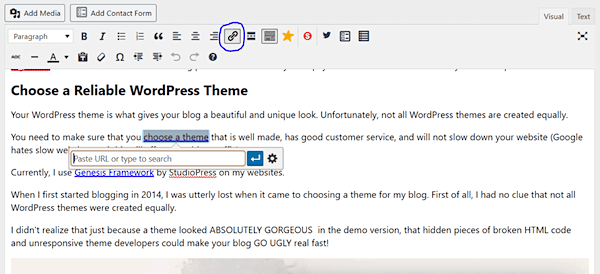
Next, you would click on the link icon (circled in blue). When the information bar pops up, add your short link and hit the blue arrow to make it stick.
4. Drive Traffic to Your Affiliate Offers
The best way to increase your affiliate sales and earnings is to drive more traffic to your content.
Creating SEO-friendly content will help you to get more traffic from search engines.
Creating content that is good for SEO includes using keywords and key phrases that are being searched online by readers and formatting that content in such a way that it is optimized for Google, Yahoo, etc.
Sharing your content via social media is also a great way to increase affiliate sales.
For instance, you can use Pinterest to share pins that lead to your blog post content.
You can also use Pinterest to share pins that lead directly to your affiliate offers.
If sharing a pin that leads directly to an affiliate offer, you want to make sure that in your pin description area you disclose the fact that you are using an affiliate link.
What types of content work well to promote affiliate offers?
Product Reviews and Tutorials
Product reviews are a great way to share what you know about a product and include your affiliate link.
Turning a written product review into a video is a great way to increase your reach and drive more traffic to your content. Here’s a product review example.
Tutorials also work well for promoting an affiliate offer because you are offering a step-by-step guide on how to best use the product or service. Here’s a tutorial example.
Resource Page
Your resource page on your blog is also a great spot to include affiliate links.
Readers typically visit resource pages for the sole purpose of finding out what tools you love to use as a blogger.
So adding your affiliate links within the content on your resource page is a good move.
Email Content
Email marketing: when sending a newsletter, include affiliate links within the body of your emails is a great way to promote products and make affiliate sales.
This method, however, comes with an extra caveat.
Some affiliate platforms (like Amazon Associates) do not allow you to include their affiliate links in emails.
Make sure that when signing up for an affiliate program you understand the rules of that program.
What are the rules for disclosing your affiliate partnerships legally?
When creating content that will include affiliate links, you want to make sure that you disclose this information at the beginning of your blog post.
The FTC requires that any affiliate or sponsored links be properly disclosed to your audience so that they know in advance that you may potentially earn a commission from any link they click within your content.
This goes for blog posts, social media, email lists, etc.
Disclosing your affiliate relationship is pretty easy. Simply get the Legal Bundle which includes templates for all 3 of your required legal pages.
Always include a line at the top of each blog post, to let people know your website uses affiliate links.
Important: Make sure you read this guide How to blog legally, as an affiliate marketer
Types Of Affiliate Marketing Websites
There are many different types of affiliate marketing websites. Once you have your website installed, you should decide what type of format it will have.
Here are the 5 main types of affiliate marketing websites:
Personal Blog
Creating an affiliate marketing website that operates as a personal blog will often mean that you are the ‘face’ of the business.
You write about your personal opinions and experiences related to the affiliate products you promote.
You also share personal stories about yourself or your family alongside your affiliate promotions.
You blog about a variety of topics and may or may not have one defined niche.
You engage in the comments and on social media as your self (not as a company) and give an overall ‘personal’ touch to your affiliate marketing websites.
Authority Niche Blog
An authority niche blog is a professional blog that may or may not have a person that is the ‘face’ of the website.
An authority niche blog has a defined, specific niche and your content rarely sways from that one topic.
Your content is authoritative, teaches some sort of skill or education around the affiliate products you promote.
You don’t typically share personal stories about yourself, your family or your personal life on an authoritative niche blog.
But that isn’t to say these types of affiliate marketing websites can’t still be personal.
It’s just that your personality on an authority niche blog is shared in a more ‘professional’ manner.
This site, HerPaperRoute.com is an authority niche blog.
Reviews And Comparison Website
Writing reviews of various products and comparing products is a way to give shoppers more information, usually appearing unbiased, and nonpersonal.
These websites will often cover products in a wide range of niches.
TheWireCutter.com is an example of a reviews and comparison website.
Price Comparison Site
Travel/vacation booking websites that scan various travel and flight websites to present the cheapest flights are price comparison websites.
Comparing prices on insurance, banks, and other large ticket items are common in this type of affiliate marketing website type.
NerdWallet.com is an example of this.
Authority Website
Authority websites are affiliate marketing websites that do not tend to have a ‘person’ behind them (as with blogs).
But rather, authority websites provide authoritative information about affiliate products, usually in just one defined niche.
TheSpruce.com and LifeWire.com are examples of this.
Of these 5 types of affiliate marketing websites, which makes the most money?
You would probably assume that the big authority websites would make the most money.
But when it comes to making your own affiliate marketing website, the format you follow isn’t the thing that determines if you will make money or not.
In all honesty, the one thing that determines if your website will be profitable or not is THIS!
How To Make Money Fast With Affiliate Marketing
These four steps could be considered affiliate marketing website strategies, or simply just good affiliate marketing best practices in general.
What’s worked for me to be successful in affiliate marketing has always been:
1. Provide honest, accurate recommendations about products that I use personally.
Easy-peasy.
2. Create interesting content that gives people more information about a product.
Go in-depth explaining why I like a product, exactly what it does and how it has helped me.
3. Create free content to encourage more affiliate sales
Create content like a downloadable cheat sheet or a course or training around how to use the affiliate product.
Then give away this content for free. Then when they upgrade to a paid plan I earn a commission for the referral.
By providing useful content and giving it away for free, you can help more people, while earning more commissions yourself.
You can also create nearly-free content. For example, I teach a course on how to run a drop shipping store on Shopify, which people can enroll in for just $7. Inside, I give an extended free trial of Shopify so my students can use the platform for free while they learn how to create their shop.
4. Create A Bonus
Offer your readers a bonus incentive for purchasing an affiliate product via your link.
Considering giving a free copy of your premium ebook when someone purchases your affiliate product.
How to Create an Affiliate Marketing Plan
My hope is that you walk away from this post knowing that sharing affiliate links to products and services you love and believe in is a great way to make affiliate marketing work for any online business model.
Success with affiliate marketing starts with a good plan.
I offer more affiliate marketing tips inside the Affiliate Marketing Income Planner.
The planner walks you through a step-by-step process of how to make affiliate income from your blog.
If you are looking for an even more in-depth affiliate marketing course, enroll in my very best affiliate marketing course bundle.
Learn Affiliate Marketing For Beginners – Success Tips
Affiliate marketing can be a game-changer in terms of earning money with your blog.
- Build relationships with your audience
- Provide helpful and useful content
- Support your fellow bloggers
- Create free training or bonus content for your audience, as an incentive to increase affiliate sales
- Above all be honest!
Learn Affiliate Marketing – Conclusion
Do you have an affiliate marketing strategy in place? Which of the tips from this post will you implement next?
To learn more about affiliate marketing, how to run a profitable affiliate blog, and make money fast get yourself a copy of the Affiliate Marketing Strategy ebook.
Learn Affiliate Marketing – Related:
- 3 Affiliate Marketing Myths That Are Keeping You Broke
- 5 High Paying Affiliate Programs You Need to Be In
- How To Write High-Converting Affiliate Reviews
- High-Paying Affiliate Programs Directory
- How To Make $100,000 With A Travel Blog
I’ll Write You A Weekly Love Letter With Helpful Money-Making Tips
To get an affiliate marketing/blogging tip each week via a love letter from me, sign up to become a HerPaperRoute member below.
You will get instant access to my Entrepreneur Toolkit, a resource library of blogging tools too. You’ll be in good company: we have 20,000 members!
There is no cost to be a member, and you can unsubscribe at any time.

Follow along on Instagram!



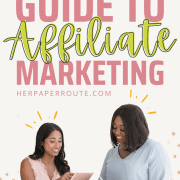
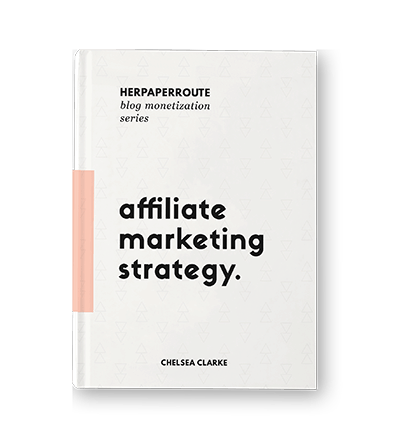

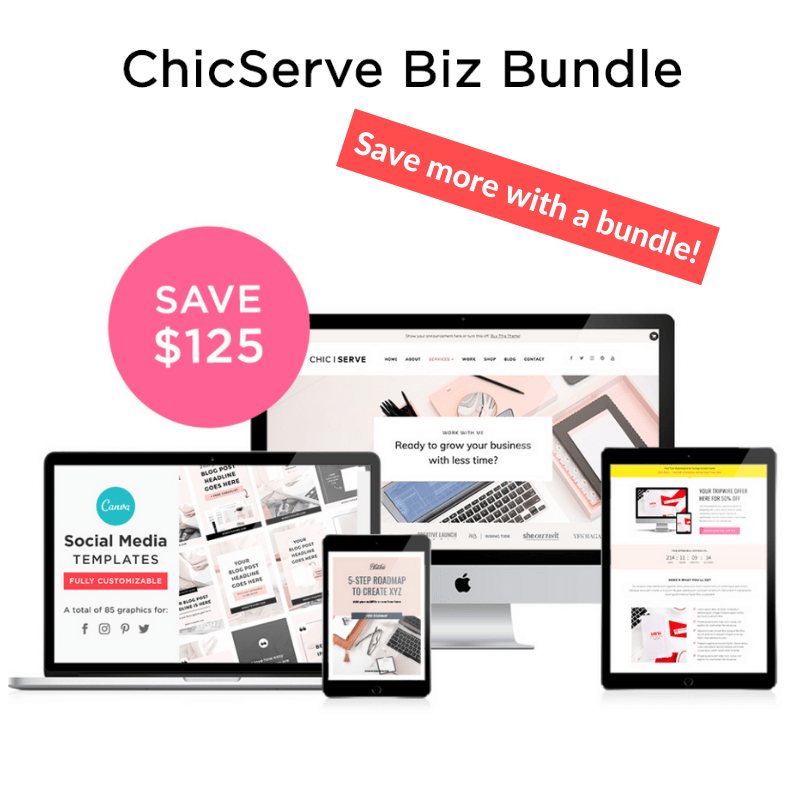


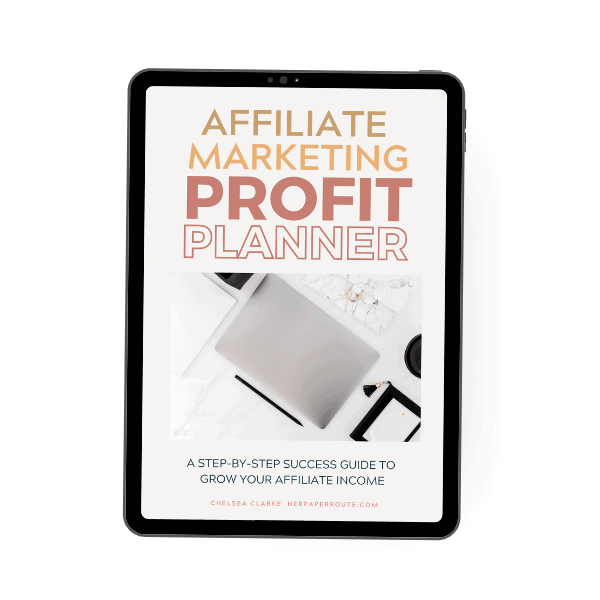

![How Does Ibotta Make Money? [How To Use Ibotta For Fast Cash] 19 woman holding phone reading How Does Ibotta Make Money](https://herpaperroute.com/wp-content/uploads/2021/11/How-Does-Ibotta-Make-Money-768x410.jpeg)




